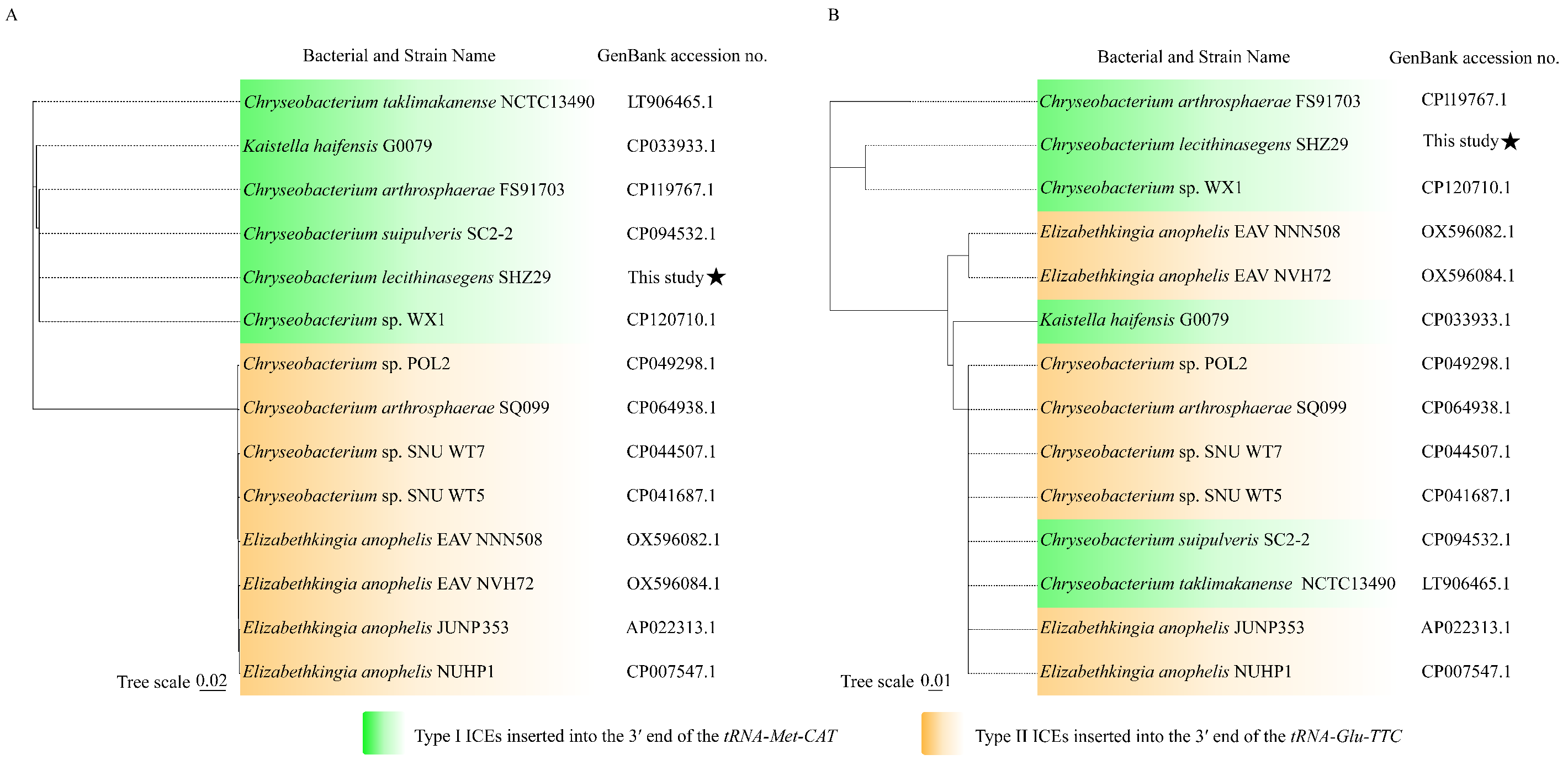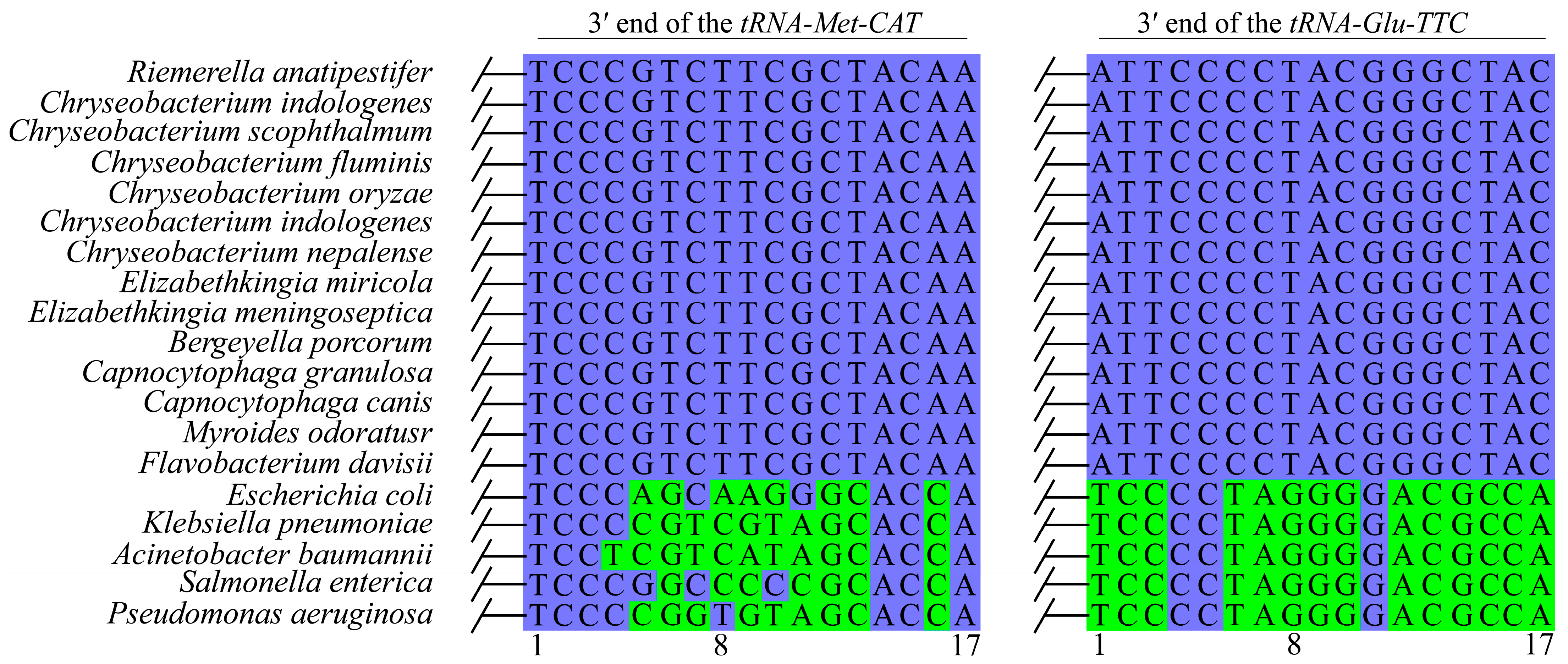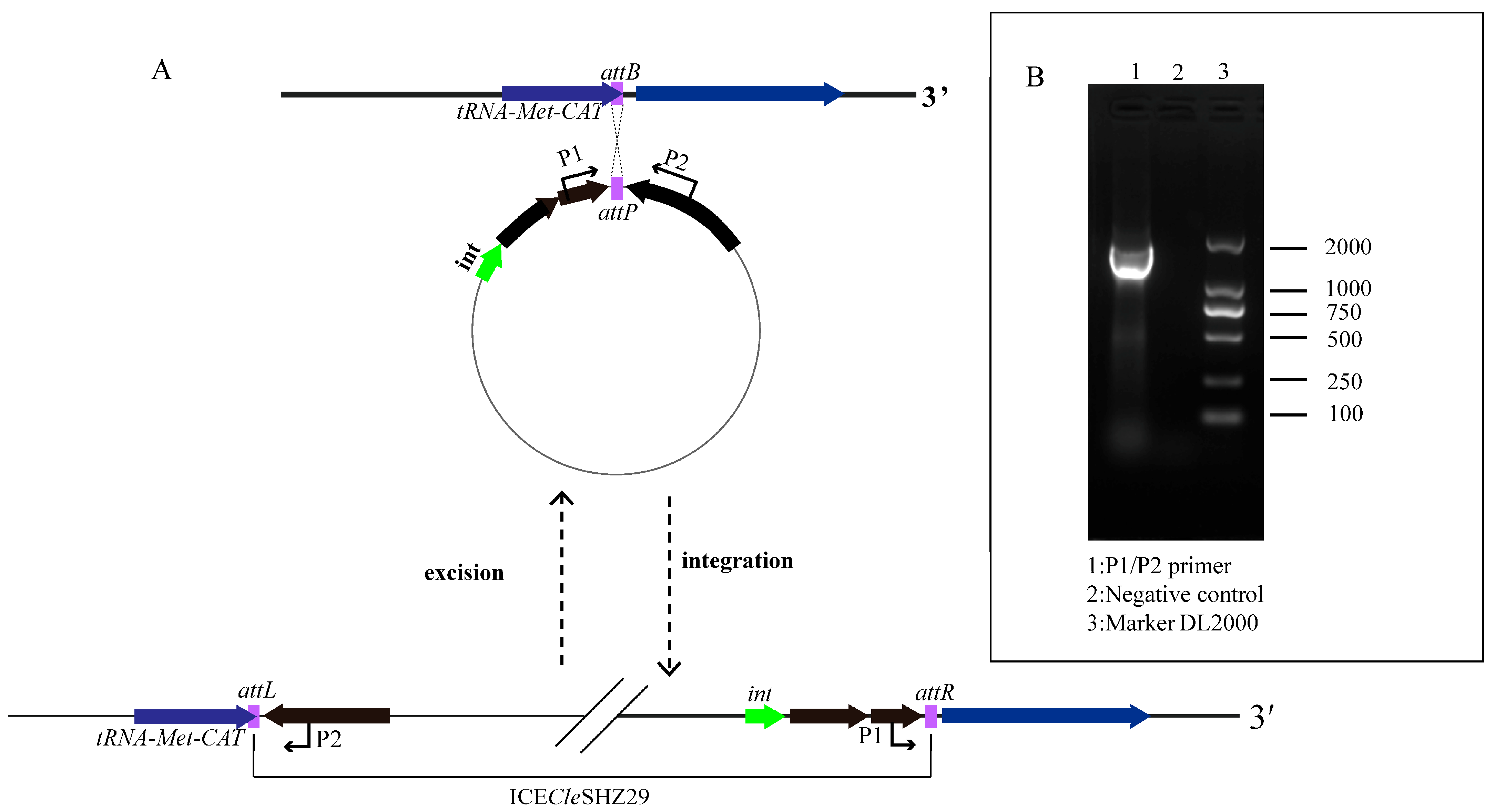ICECleSHZ29: Novel Integrative and Conjugative Element (ICE)-Carrying Tigecycline Resistance Gene tet(X6) in Chryseobacterium lecithinasegens
Abstract
1. Introduction
2. Results and Discussion
2.1. C. lecithinasegens SHZ29 Is a Multidrug-Resistant Strain
2.2. Structure of ICECleSHZ29
2.3. Phylogentic Analysis of ICECleSHZ29
2.4. Detection of Circular Intermediate Form
3. Materials and Methods
3.1. Bacteria Strain and Antimicrobial Susceptibility Testing
3.2. Whole Genome Sequencing and Bioinformatic Analyses
3.3. Phylogenetic Analysis and Sequence Comparison
3.4. Detection of Circular Intermediates of ICECleSHZ29 and Conjugation Experiments
3.5. Nucleotide Sequence Accession Number
4. Conclusions
Supplementary Materials
Author Contributions
Funding
Institutional Review Board Statement
Data Availability Statement
Conflicts of Interest
References
- He, L.Y.; Ying, G.G.; Liu, Y.S.; Su, H.C.; Chen, J.; Liu, S.S.; Zhao, J.L. Discharge of swine wastes risks water quality and food safety: Antibiotics and antibiotic resistance genes from swine sources to the receiving environments. Environ. Int. 2016, 92–93, 210–219. [Google Scholar] [CrossRef]
- Burrus, V.; Waldor, M.K. Shaping bacterial genomes with integrative and conjugative elements. Res. Microbiol. 2004, 155, 376–386. [Google Scholar] [CrossRef]
- Burrus, V.; Marrero, J.; Waldor, M.K. The current ICE age: Biology and evolution of SXT-related integrating conjugative elements. Plasmid 2006, 55, 173–183. [Google Scholar] [CrossRef]
- Wozniak, R.A.; Waldor, M.K. Integrative and conjugative elements: Mosaic mobile genetic elements enabling dynamic lateral gene flow. Nat. Rev. Microbiol. 2010, 8, 552–563. [Google Scholar] [CrossRef]
- Zhang, J.; Yang, Y.; Sun, H.; Luo, X.; Cui, X.; Miao, Q.; He, D.; Zhao, J.; Yan, F.; Pan, Y.; et al. Prevalence of the optrA gene among Streptococcus suis isolates from diseased pigs and identification of a novel integrative conjugative element ICESsu988S. Res. Microbiol. 2023, 174, 104078. [Google Scholar] [CrossRef]
- Gao, Y.; Xia, L.; Pan, R.; Xuan, H.; Guo, H.; Song, Q.; Wei, J.; Shao, D.; Liu, K.; Li, Z.; et al. Identification of mcr-1 and a novel chloramphenicol resistance gene catT on an integrative and conjugative element in an Actinobacillus strain of swine origin. Vet. Microbiol. 2021, 254, 108983. [Google Scholar] [CrossRef] [PubMed]
- Kong, L.H.; Xiang, R.; Wang, Y.L.; Wu, S.K.; Lei, C.W.; Kang, Z.Z.; Chen, Y.P.; Ye, X.L.; Lai, Y.; Wang, H.N. Integration of the blaNDM-1 carbapenemase gene into a novel SXT/R391 integrative and conjugative element in Proteus vulgaris. J. Antimicrob. Chemother. 2020, 75, 1439–1442. [Google Scholar] [CrossRef] [PubMed]
- He, J.; Sun, L.; Zhang, L.; Leptihn, S.; Yu, Y.; Hua, X. A Novel SXT/R391 Integrative and Conjugative Element Carries Two Copies of the blaNDM-1 Gene in Proteus mirabilis. mSphere 2021, 6, e0058821. [Google Scholar] [CrossRef]
- Yaghoubi, S.; Zekiy, A.O.; Krutova, M.; Gholami, M.; Kouhsari, E.; Sholeh, M.; Ghafouri, Z.; Maleki, F. Tigecycline antibacterial activity, clinical effectiveness, and mechanisms and epidemiology of resistance: Narrative review. Eur. J. Clin. Microbiol. Infect. Dis. 2022, 41, 1003–1022. [Google Scholar] [CrossRef] [PubMed]
- He, T.; Wang, R.; Liu, D.; Walsh, T.R.; Zhang, R.; Lv, Y.; Ke, Y.; Ji, Q.; Wei, R.; Liu, Z.; et al. Emergence of plasmid-mediated high-level tigecycline resistance genes in animals and humans. Nat. Microbiol. 2019, 4, 1450–1456. [Google Scholar] [CrossRef]
- Lu, X.; Zhang, L.; Peng, K.; Wang, Q.; Liu, R.; Wang, Z.; Li, R. Characterisation of a Novel Tigecycline Resistance Gene tet(X22) and its Coexistence with blaNDM-1 in a Pseudomonas caeni Isolate. Int. J. Antimicrob. Agents 2023, 62, 106961. [Google Scholar] [CrossRef]
- He, D.; Wang, L.; Zhao, S.; Liu, L.; Liu, J.; Hu, G.; Pan, Y. A novel tigecycline resistance gene, tet(X6), on an SXT/R391 integrative and conjugative element in a Proteus genomospecies 6 isolate of retail meat origin. J. Antimicrob. Chemother. 2020, 75, 1159–1164. [Google Scholar] [CrossRef]
- Liu, D.; Zhai, W.; Song, H.; Fu, Y.; Schwarz, S.; He, T.; Bai, L.; Wang, Y.; Walsh, T.R.; Shen, J. Identification of the novel tigecycline resistance gene tet(X6) and its variants in Myroides, Acinetobacter and Proteus of food animal origin. J. Antimicrob. Chemother. 2020, 75, 1428–1431. [Google Scholar] [CrossRef]
- Wang, C.Z.; Gao, X.; Lv, L.C.; Cai, Z.P.; Yang, J.; Liu, J.H. Novel tigecycline resistance gene cluster tnfxB3-tmexCD3-toprJ1b in Proteus spp. and Pseudomonas aeruginosa, co-existing with tet(X6) on an SXT/R391 integrative and conjugative element. J. Antimicrob. Chemother. 2021, 76, 3159–3167. [Google Scholar] [CrossRef] [PubMed]
- Jin, H.; Jia, Q.; Jin, X.; Zhu, X.; Wang, M.G.; Sun, R.Y.; Cui, C. Identification of novel Tet(X6)-Tet(X2) recombinant variant in Elizabethkingia meningoseptica from a bullfrog farm and downstream river in China. Front. Microbiol. 2024, 15, 1453801. [Google Scholar] [CrossRef]
- Usui, M.; Fukuda, A.; Suzuki, Y.; Nakajima, C.; Tamura, Y. Broad-host-range IncW plasmid harbouring tet(X) in Escherichia coli isolated from pigs in Japan. J. Glob. Antimicrob. Resist. 2022, 28, 97–101. [Google Scholar] [CrossRef] [PubMed]
- Li, R.; Peng, K.; Li, Y.; Liu, Y.; Wang, Z. Exploring tet(X)-bearing tigecycline-resistant bacteria of swine farming environments. Sci. Total Environ. 2020, 733, 139306. [Google Scholar] [CrossRef]
- Dong, N.; Liu, C.; Hu, Y.; Lu, J.; Zeng, Y.; Chen, G.; Chen, S.; Zhang, R. Emergence of an Extensive Drug Resistant Pseudomonas aeruginosa Strain of Chicken Origin Carrying blaIMP-45, tet(X6), and tmexCD3-toprJ3 on an IncpRBL16 Plasmid. Microbiol. Spectr. 2022, 10, e0228322. [Google Scholar] [CrossRef] [PubMed]
- Arouna, O.; Deluca, F.; Camara, M.; Fall, B.; Fall, B.; Ba Diallo, A.; Docquier, J.D.; Mboup, S. Chryseobacterium gleum in a man with prostatectomy in Senegal: A case report and review of the literature. J. Med. Case Rep. 2017, 11, 118. [Google Scholar] [CrossRef]
- Omar, A.; Camara, M.; Fall, S.; Ngom-Cisse, S.; Fall, B.; Ba-Diallo, A.; Diop-Ndiaye, H.; Toure-Kane, C.; Mboup, S.; Gaye-Diallo, A. Chryseobacterium indologenes in a woman with acute leukemia in Senegal: A case report. J. Med. Case Rep. 2014, 8, 138. [Google Scholar] [CrossRef]
- Klimkaitė, L.; Ragaišis, I.; Krasauskas, R.; Ružauskas, M.; Sužiedėlienė, E.; Armalytė, J. Novel Antibiotic Resistance Genes Identified by Functional Gene Library Screening in Stenotrophomonas maltophilia and Chryseobacterium spp. Bacteria of Soil Origin. Int. J. Mol. Sci. 2023, 24, 6037. [Google Scholar] [CrossRef]
- Zhu, X.; Wang, X.; Wang, F.; Tian, X.; Pang, J. The integrative and conjugative element ICECiPOL15 mediates horizontal transfer of β-lactam resistance gene in Chryseobacterium indoltheticum POL15. J. Glob. Antimicrob. Resist. 2024, 36, 223–229. [Google Scholar] [CrossRef]
- Fu, J.; Zhong, C.; Zhou, Y.; Lu, M.; Zong, G.; Zhang, P.; Cheng, M.; Cao, G. The Integrative and Conjugative Element ICECspPOL2 Contributes to the Outbreak of Multi-Antibiotic-Resistant Bacteria for Chryseobacterium Spp. and Elizabethkingia Spp. Microbiol. Spectr. 2021, 9, e0200521. [Google Scholar] [CrossRef]
- Qian, C.; Ma, Z.; Feng, L.; Guo, W.; Han, Y.; Zhang, Y.; Xu, C.; Cao, J.; Zhou, T. Emergence of tet(X2) in Acinetobacter pittii confers clinical resistance to tigecycline. J. Antimicrob. Chemother. 2023, 78, 1543–1546. [Google Scholar] [CrossRef]
- Speer, B.S.; Bedzyk, L.; Salyers, A.A. Evidence that a novel tetracycline resistance gene found on two Bacteroides transposons encodes an NADP-requiring oxidoreductase. J. Bacteriol. 1991, 173, 176–183. [Google Scholar] [CrossRef] [PubMed]
- Luo, Y.; Chen, M.; Jiang, Y.; Wang, W.; Wang, H.; Deng, L.; Zhao, Z. Study on the Genome and Mechanism of Tigecycline Resistance of a Clinical Chryseobacterium indologenes Strain. Microb. Drug Resist. 2023, 29, 541–551. [Google Scholar] [CrossRef] [PubMed]
- Wozniak, R.A.; Fouts, D.E.; Spagnoletti, M.; Colombo, M.M.; Ceccarelli, D.; Garriss, G.; Déry, C.; Burrus, V.; Waldor, M.K. Comparative ICE genomics: Insights into the evolution of the SXT/R391 family of ICEs. PLoS Genet. 2009, 5, e1000786. [Google Scholar] [CrossRef]
- Toleman, M.A.; Bennett, P.M.; Walsh, T.R. ISCR elements: Novel gene-capturing systems of the 21st century? Microbiol. Mol. Biol. Rev. 2006, 70, 296–316. [Google Scholar] [CrossRef]
- Johnson, C.M.; Grossman, A.D. Integrative and Conjugative Elements (ICEs): What They Do and How They Work. Annu. Rev. Genet. 2015, 49, 577–601. [Google Scholar] [CrossRef]
- Liu, M.; Liu, J.; Liu, G.; Wang, H.; Wang, X.; Deng, Z.; He, Y.; Ou, H.Y. ICEO, a biological ontology for representing and analyzing bacterial integrative and conjugative elements. Sci. Data 2022, 9, 11. [Google Scholar] [CrossRef] [PubMed]
- Roberts, A.P.; Mullany, P. A modular master on the move: The Tn916 family of mobile genetic elements. Trends Microbiol. 2009, 17, 251–258. [Google Scholar] [CrossRef]
- Roberts, A.P.; Mullany, P. Tn916-like genetic elements: A diverse group of modular mobile elements conferring antibiotic resistance. FEMS Microbiol. Rev. 2011, 35, 856–871. [Google Scholar] [CrossRef]
- Ambroset, C.; Coluzzi, C.; Guédon, G.; Devignes, M.D.; Loux, V.; Lacroix, T.; Payot, S.; Leblond-Bourget, N. New Insights into the Classification and Integration Specificity of Streptococcus Integrative Conjugative Elements through Extensive Genome Exploration. Front. Microbiol. 2015, 6, 1483. [Google Scholar] [CrossRef]
- Hsueh, P.R.; Teng, L.J.; Yang, P.C.; Ho, S.W.; Luh, K.T. Susceptibilities of Chryseobacterium indologenes and Chryseobacterium meningosepticum to cefepime and cefpirome. J. Clin. Microbiol. 1997, 35, 3323–3324. [Google Scholar] [CrossRef]
- Fraser, S.L.; Jorgensen, J.H. Reappraisal of the antimicrobial susceptibilities of Chryseobacterium and Flavobacterium species and methods for reliable susceptibility testing. Antimicrob. Agents Chemother. 1997, 41, 2738–2741. [Google Scholar] [CrossRef]
- Alav, I.; Sutton, J.M.; Rahman, K.M. Role of bacterial efflux pumps in biofilm formation. J. Antimicrob. Chemother. 2018, 73, 2003–2020. [Google Scholar] [CrossRef] [PubMed]
- Zhang, Y.; Li, D.; Yang, Y.; Su, J.; Xu, X.; Wang, M.; Chen, Y.; Li, Y. Clinical and molecular characteristics of Chryseobacterium indologenes isolates at a teaching hospital in Shanghai, China. Ann. Transl. Med. 2021, 9, 668. [Google Scholar] [CrossRef]
- Aminov, R. Acquisition and Spread of Antimicrobial Resistance: A tet(X) Case Study. Int. J. Mol. Sci. 2021, 22, 3905. [Google Scholar] [CrossRef] [PubMed]
- Luo, R.; Liu, B.; Xie, Y.; Li, Z.; Huang, W.; Yuan, J.; He, G.; Chen, Y.; Pan, Q.; Liu, Y.; et al. SOAPdenovo2: An empirically improved memory-efficient short-read de novo assembler. Gigascience 2012, 1, 18. [Google Scholar] [CrossRef]
- Zankari, E.; Hasman, H.; Cosentino, S.; Vestergaard, M.; Rasmussen, S.; Lund, O.; Aarestrup, F.M.; Larsen, M.V. Identification of acquired antimicrobial resistance genes. J. Antimicrob. Chemother. 2012, 67, 2640–2644. [Google Scholar] [CrossRef] [PubMed]
- Liu, M.; Li, X.; Xie, Y.; Bi, D.; Sun, J.; Li, J.; Tai, C.; Deng, Z.; Ou, H.Y. ICEberg 2.0: An updated database of bacterial integrative and conjugative elements. Nucleic Acids Res. 2019, 47, D660–D665. [Google Scholar] [CrossRef] [PubMed]
- Tamura, K.; Stecher, G.; Kumar, S. MEGA11: Molecular Evolutionary Genetics Analysis Version 11. Mol. Biol. Evol. 2021, 38, 3022–3027. [Google Scholar] [CrossRef] [PubMed]
- Xu, J.; Jia, H.; Cui, G.; Tong, H.; Wei, J.; Shao, D.; Liu, K.; Qiu, Y.; Li, B.; Ma, Z. ICEAplChn1, a novel SXT/R391 integrative conjugative element (ICE), carrying multiple antibiotic resistance genes in Actinobacillus pleuropneumoniae. Vet. Microbiol. 2018, 220, 18–23. [Google Scholar] [CrossRef] [PubMed]




Disclaimer/Publisher’s Note: The statements, opinions and data contained in all publications are solely those of the individual author(s) and contributor(s) and not of MDPI and/or the editor(s). MDPI and/or the editor(s) disclaim responsibility for any injury to people or property resulting from any ideas, methods, instructions or products referred to in the content. |
© 2025 by the authors. Licensee MDPI, Basel, Switzerland. This article is an open access article distributed under the terms and conditions of the Creative Commons Attribution (CC BY) license (https://creativecommons.org/licenses/by/4.0/).
Share and Cite
Chen, X.; Zhang, Y.; Jiang, C.; Lin, Y.; Yao, X.; Nie, W.; Li, L.; Wei, J.; Shao, D.; Liu, K.; et al. ICECleSHZ29: Novel Integrative and Conjugative Element (ICE)-Carrying Tigecycline Resistance Gene tet(X6) in Chryseobacterium lecithinasegens. Antibiotics 2025, 14, 1002. https://doi.org/10.3390/antibiotics14101002
Chen X, Zhang Y, Jiang C, Lin Y, Yao X, Nie W, Li L, Wei J, Shao D, Liu K, et al. ICECleSHZ29: Novel Integrative and Conjugative Element (ICE)-Carrying Tigecycline Resistance Gene tet(X6) in Chryseobacterium lecithinasegens. Antibiotics. 2025; 14(10):1002. https://doi.org/10.3390/antibiotics14101002
Chicago/Turabian StyleChen, Xi, Yifei Zhang, Chunling Jiang, Yafang Lin, Xiaohui Yao, Wansen Nie, Lin Li, Jianchao Wei, Donghua Shao, Ke Liu, and et al. 2025. "ICECleSHZ29: Novel Integrative and Conjugative Element (ICE)-Carrying Tigecycline Resistance Gene tet(X6) in Chryseobacterium lecithinasegens" Antibiotics 14, no. 10: 1002. https://doi.org/10.3390/antibiotics14101002
APA StyleChen, X., Zhang, Y., Jiang, C., Lin, Y., Yao, X., Nie, W., Li, L., Wei, J., Shao, D., Liu, K., Li, Z., Qiu, Y., Ma, Z., Li, B., & Xia, L. (2025). ICECleSHZ29: Novel Integrative and Conjugative Element (ICE)-Carrying Tigecycline Resistance Gene tet(X6) in Chryseobacterium lecithinasegens. Antibiotics, 14(10), 1002. https://doi.org/10.3390/antibiotics14101002







